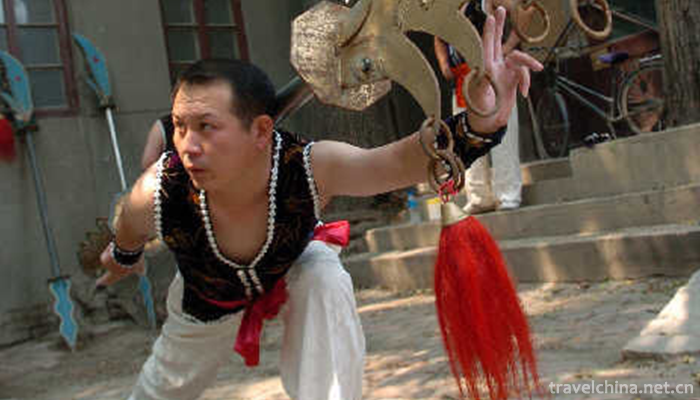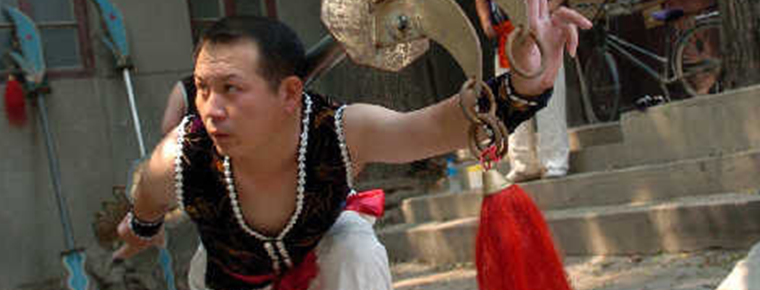Hui Heavy Knife Wushu
Hui Heavy Knife Wushu
Heavy knife is the original name of big knife. It is a traditional weapon around Beijing and Tianjin. It has a history of thousands of years in China. The original name of Jinmen Hui Dao is "Cao Men Dao Style". It is a set of Dao Style left over by Cao Jinzao, a great swordsman of Jinmen. After the enrichment and innovation of his son, Mr. Cao Keming, it has become a complete and unique set of Dao Style, which has been enriched and passed on in the family. It has a history of more than 100 years and has been passed on to the seventh generation.
On May 20, 2006, the heritage was approved by the State Council and listed in the first batch of national intangible cultural heritage list.
Tracing to the source
Tianjin Hui Dao became famous in the early years of Chengzu in Ming Dynasty. It is said that a Jinling Hui General of Zhu Di, king of Yan, used to fight with a 60-kilogram Dao. He traveled with Zhu Di to settle Tianjin in the northern expedition, and then moved his family to Tianjin, so he had the Cao Dao of Jinmen.
Tianjin Municipal Hui Dao Team is inherited by Mr. Cao Keming, a famous Hui Wushu master in Jinmen, who inherited the legacy of his father Cao Jinzao (1889-1966). It carries forward the spirit of strengthening the body and patriotism of Wushu. It has been excavated and sorted out on the basis of such Kungfu as Benmen Dao, Zheng, Baoshi and Quanshovel, and created the "Cao Men Dao Style", which has been handed down for more than five generations. It has a history of more than a hundred years now, and is in Jinmen Style. The altar is unique.
The performance tool used by the Jinshi Hui Dao Team weighs up to 80 kilograms and is also the heirloom of Cao Men. In the 7th National Minority Games, Tianjin delegation's Jinmen Hui broadsword performance caused a great sensation. "The knife dances like the wind, the knife falls silently, lifts the knife jacks, dances the knife featherlessly". These hymns vividly describe the charm of the Hui Dao in Jinmen.
Ten Hercules entered the hall with a knife of tens of kilograms and nearly one hundred kilograms. Accompanied by beautiful music, they performed various kinds of knife techniques that were dazzling, such as lifting, grasping, twisting, turning and throwing, lifting, necking, falling to the ground, flying back and splitting water. Each routine and action embodied the characteristics of combining rigidity with flexibility, movement and silence, and showed the national characteristics of the Hui compatriots'martial fitness. It fully embodies the nationality, tradition, skill and ornamentation.
Inheritance significance
The Hui Dao troop now has the Dao, Stone Horn, Stone Lock and Baoshi retained during the Qing Dynasty. One of them is the largest stone lock in the country, weighing up to 200 kg. Zhang Jinbiao, the first disciple of Cao Men, who can lift the stone with one arm, is the first-generation disciple of Cao Men. Among them, Baoshi is the top stone bestowed by the Qing Dynasty emperor, inscribed on the stone is the inscription of a golden bang, weighing more than 400 kg.
The purpose of "Cao Men Dao Style" is to carry forward the spirit of national Wushu, strengthen national unity, and practice Wushu fitness. In the past reports, we have achieved good results and won praise from people from all walks of life at home and abroad.
The state attaches great importance to the protection of intangible cultural heritage. On May 20, 2006, the intangible cultural heritage was approved by the State Council and listed in the first batch of national intangible cultural heritage list. On June 5, 2007, determined by the Ministry of Culture, Cao Shijie of Tianjin was the representative successor of this cultural heritage project, and was included in the list of 226 representative successors of the first batch of national intangible cultural heritage projects.


-
2.Royal Prime Ministers Palace
Huangcheng Xiangfu (National AAAAA Scenic Area) is located in Beiliu Town, Yangcheng County, Jincheng City, Shanxi Province.
Time 2018-11-24 -
3.Dongping Lake Scenic Spot
The total area of Dongping Lake Scenic Spot is 627 square kilometers, the annual water surface is 209 square kilometers, the average water depth is 2.5 meters, and the total water storage is 4 billion
Time 2018-12-20 -
4.Harbin Amusement Park
Harbin amusement park is located at the junction of the outer Road area and Nangang District. It was founded in 1958. Originally known as Harbin Cultural Park, it covers an area of 22.8 hectares.
Time 2019-01-13 -
5.Black Valley Scenic Area
Black Valley, National AAAAA Tourist Scenic Spot, National Forest Park, National Geopark, China's Best Leisure Mountain, China's Best Green Low Carbon Tourist Leisure Spot
Time 2019-01-13 -
6.Hometown of Huang Di
The scenic spot of Huangdi's hometown is located in Xuanyuan Road, Xinzheng City, Zhengzhou City, Henan Province. It is the residence of Xiong clan recorded in the history
Time 2019-01-18 -
7.Western Grand Canyon
Western Grand Canyon Hot Spring is a national AAAA-level tourist attraction, located in Shuifu City, Yunnan Province, 32 kilometers away from Yibin City, Sichuan Province
Time 2019-02-25 -
8.Sintering Techniques of Chengcheng Yaotou Ceramics
Yaotou Ceramic Firing Skill in Chengcheng, a traditional handicraft in Yaotou Town, Chengcheng County, east of Guanzhong, Shaanxi Province, is one of the national intangible cultural heritages.
Time 2019-04-18 -
9.Tajik costumes
Tajik costume refers to the costume with distinct ethnic characteristics of Tajik. Tajik people mainly live in the Pamir Plateau with cold climate. Their economic life is mainly animal husbandry and a
Time 2019-06-17 -
10.Tajik Folk Songs
Tajik folk songs are very rich in content. The folk songs handed down to this day include folk songs reflecting ancient social life, customs and customs, eulogizing love and religious rituals. The mai
Time 2019-06-17 -
11.Wu Anpings tune
Wu'anping DiaoLaozi originated in the late Ming and early Qing Dynasty. Wu'anping DiaoLaozi and Wu'anluozi are two unique local operas in Wu'an City, Hebei Province. They are often performed together.
Time 2019-06-30 -
12.Cao Zhen
Cao Zhen(? - 231 years' name, Qin Zhen, Zi Dan. Pei country Qiao County (now Anhui) Bozhou City) people. Three countries Time Cao Wei Famous soldier, Emperor Wei Wu Cao Cao Foster son.
Time 2019-09-15